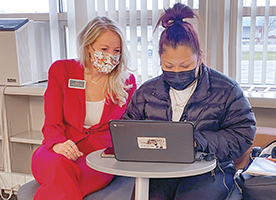Engagement in a Virtual Learning Environment
February 01, 2022
A veteran online education leader shares her strategies for raising the quality of what transpires between teacher and students

Maintaining high levels of student engagement and motivation are important in any learning environment, but it is of critical importance in an online classroom.
When students are learning from a distance, leaders, teachers, and support staff
must all work together to ensure students not only attend class but are engaged in meaningful learning. This can feel like a challenge.
While online learning may feel new to many of us, virtual education itself is not new. Successful online
programs and schools have been tackling this challenge for years, and there are several strategies that any online program or classroom can use to increase student attendance and learner engagement.
This Content is Exclusive to Members
AASA Member? Login to Access the Full Resource
Not a Member? Join Now | Learn More About Membership
Practices for Lifting Online Engagement
Several research-based practices that have been proven to raise online learner engagement are part of our routines at the Warren Online Academy in Indianapolis. I believe these are relatively easy-to-implement instructional strategies.
- Design assessments with multiple points of engagement.
What: Instead of creating online projects with multiple steps to follow, break larger assignments up into smaller, more manageable tasks.
Why: This strategy is beneficial for multiple reasons. One, it allows you to give feedback during the learning process instead of just at the end. Two, it allows students to get more opportunities for success while making the assignment seem less daunting.
Research and references: The Meaningful Writing Project (Eodice, 2017); “Moving From Feedback to Feedforward” (Gonzalez, 2018) - Use conditional release tools if available.
What: Some learning management systems or curriculum platforms give teachers the option to design lessons that help structure the learning a bit more for students. Activities and resources are unlocked for students upon completion of the previous activity.
Why: Conditional release creates structure and scaffolding for students. A well-organized course helps students progress and know what is expected of them. This leads to higher levels of on-task behavior.
Research and references: “Best Practices for Conditional Releases” (Dreon, 2019); “The Effects of Conditional Release of Course Materials on Student Performance” (Fisher et al., Journal of Student Success and Retention, 2015) - Increase your teacher presence.
What: Especially in asynchronous online environments, a teacher’s presence is critical. This includes being in the videos you give students, timely feedback (audio and video feedback included) and participation in discussions and other learning activities.
Why: A strong teacher presence leads to more investment from students, an online experience that is more humanized, increased critical thinking displayed in student responses and lower levels of academic dishonesty.
Research and references: “An Analysis of Faculty Promotion of Critical Thinking and Peer Interaction within Threaded Discussions” (Belcher et al., OLJ, 2015) and “Testing a Model to Predict Online Cheating — Much Ado About Nothing” (Beck, Active Learning in Higher Education, 2014) - Nudge students in the right direction.
What: Be intentional with your communication to students. Ask guiding questions to lead students to reflect on how their habits are impacting their engagement and ultimately their success. For example, instead of telling students they should spend more time on their lessons or demanding that students seek out help from the teacher, ask questions like “Did you set aside time to complete the lesson?” or “What is your daily routine or schedule for working on schoolwork?” or “Did you come to office hours last Wednesday?”
Why: Significant research tells us gentle “nudges” can impact our decision making, both personally and professionally. You’re likely to get a much more positive response from students by carefully restructuring communication to students when they display a lack of engagement or the practices that would lead to a successful online experience.
Research and references: Nudge by Richard Thaler and Cass Sunstein; “Small Changes, Large Rewards: How Individualized Emails Increase Classroom Performance” (Cohen, 2018) - Help students develop self-efficacy.
What: Find opportunities for all students to be successful early in a lesson or class.
Why: The No. 1 reason students are likely disengaging in an online class is not laziness or defiance, but rather a lack of belief they will be successful. When students find success early and often, their belief that they will continue to be successful grows. The opposite is also true: Repeated failure makes a student believe they will continue to fail.
Research and references: “Self-Efficacy: Toward a Unifying Theory of Behavioral Change” (Bandura, Psychological Review, 1977); “Examining Students’ Confidence to Learn Online, Self-Regulation Skills and Perceptions of Satisfaction and Usefulness of Online Classes” (Landrum, OLJ, 2020) - Provide opportunities for choice.
What: Provide students choices in the content they explore, the discussions they participate in, their assignment output (record or write, for example) and the assessments they complete.
Why: Sarah Cavanagh, author of The Spark of Learning, states, “Choice leads to greater completion, interest, enjoyment and perceived competence.”
Research and references: Chapter 2 of my book The Perfect Blend (2020) shares research and rationale for leveraging choice in online and blended environments.
Advertisement
Advertisement
Advertisement
Advertisement



